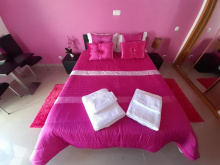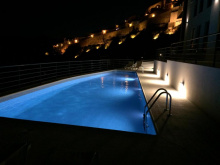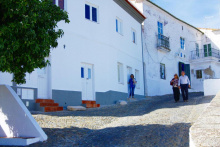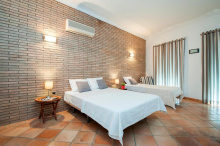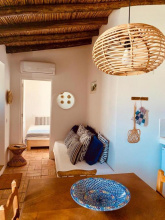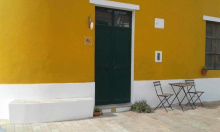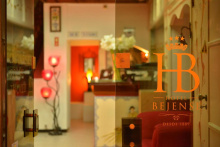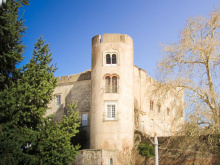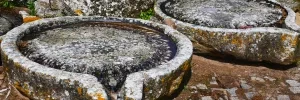Mesquita is a small village that is being revitalised in part because of the camino. Its population was down to 16 before the beginning of a development project that includes a four-bed albergue, a restaurant and several refurbished homes available for short-term rental. Staying in Mesquita is a great way to experience life in a tiny village and to inject money into the local economy.
The albergue can be booked on Booking.com but to help the village avoid paying fees, consider calling César on +351 964 879 133 and reserve directly with him (he speaks English).
Eating at the restaurant requires pre-booking. An alternative is to self-cater at the albergue, which has basic cooking facilities. The restaurant sells limited supplies including pasta and canned beans.
Leaving Mesquita, the camino follows a paved road for about 4km. A short-cut leaves the road and avoids the interesting village of Vicentes, while arrows continue on the road and pass through Vicentes, after which the two paths rejoin.
Accommodation in Mesquita
| ALBERGUE Nª SRA. NEVES |
There are several options for continuing after Lombardos and the situation can be a bit confusing, so check with César in Mesquita for the latest information.
There are several options for continuing after Lombardos and the situation can be a bit confusing, so check with César in Mesquita for the latest information. The arrows follow a long circular path that was marked before permission was granted to traverse private property that lies on a more direct path. However, the direct path requires crossing a tricky dam bridge that is only about a foot wide, with no handrails, vegetation obstacles and a potential fall of a few metres. If that doesn’t sound appealing, take the longer way or enquire about a possible third way.
Mértola is a wonderful place containing vestiges of the late Roman, Visigothic, Muslim and Reconquest eras. The adjacent castle, church and archeological site form the main historical focus of the town and can be explored in an hour or two. Keep in mind that all three are closed on Sundays and Mondays.
The castle was built as the headquarters for the Portuguese branch of the Order of Santiago in 1292, on top of earlier Muslim fortifications. The most impressive aspect of the castle is the 27m-high keep, which now contains a small museum.
In the altar of the church, the mihrab from the building’s previous incarnation is the only known remnant of a medieval mosque in Portugal. The museum underneath the church contains fragments of a paleo-Christian church that predates the mosque.
The archeological site consists of ruins of residential areas from early medieval and Muslim times. Fragments of 5th-6th century mosaics of Byzantine inspiration are the most interesting finds.
Casa do Funil is a good budget accommodation option in the centre of Mértola, with a rooftop terrace affording good views. If you’re lucky, one of the owners, Rui, will use his urban sketching skills to fashion a unique stamp in your pilgrim passport.
There are no stores between Mértola and Cabeça Gorda, so stock up on provisions in Mértola.
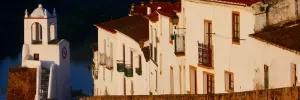
Concealed in the village of Mosteiro is an unexpected gem: one of the oldest churches in Portugal. It dates from late Roman times after being converted from an earlier secular building to a family church. Apart from a modern ceiling, the core of the original interior remains.
To visit the church, call Dona Antónia the day before on +351 962 840 066. If she’s unable to be in the village when you arrive, she’ll leave the keys at the bar / reception centre for you to pick up. The reception centre can also arrange accommodation, but Amêndoeira da Serra, 3km further on, is the more popular end-of-stage stop.

This simple village has a Cultural and Recreation Centre that provides pilgrims with food and shelter. Call Dona Maria at the centre a day ahead on +351 286 998 247 to reserve accommodation, either in a private room or a dormitory. The centre is also a café/restaurant and Dona Maria will cook dinner for a reasonable price.
Accommodation in Amendoeirra da Serra
There is a tavern for drinks but no store despite the sign at the entrance to the village saying there is one. The tavern sells bread made in the village’s communal wood-fired oven but it may be a day or two old.
For accommodation, call Zé António in advance on +351 963 539 511. He rents an entire small apartment at Avenida Alonso Gomes, 43 in the northern part of the village. This lodging can also be arranged at the junta de freguesia in the centre of town if necessary.
Beja is one of the most attractive towns in the Alentejo and can be explored in an afternoon, especially after a short stage from Cabeça Gorda. The 13th-14th century castle with a keep that towers over Beja is the main tourism focus of the town. There’s also a Visigothic Museum inside the church of Santo Amaro, next to the castle, but opening hours are sporadic. The Regional Museum of Beja, housed in a beautiful former convent, also merits a visit.
Accommodation in Beja
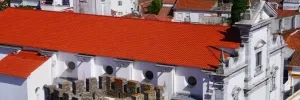
Cante Alentejano, a regional form of singing, is popular in Cuba but it is spontaneous and seeing a performance can’t be arranged in advance. For the best chance to hear this cultural art form, visit the town’s taverns in the evening.
About 2km outside Cuba, a left turn off the main road at the Toros de Núñez sign is possible, but arrows don’t point this way. This route goes through private property and several signs warn of the danger of ‘gado bravo’ (aggressive cattle). Alternatively, stay on the road.
Accommodation in Cuba
| Hospedaria do Carmo |
For an unforgettable night in a 500-year-old castle that won’t break the bank, consider staying at the Pousada Castelo Alvito.
At a fork in the road shortly after leaving Alvito, the arrows point left. This is the most direct route but consider taking the right fork to go through Água de Peixe. This unusual village consists of little more than a 16th-century palace (no entry) with ruins of millstones scattered around the entrance.
Accommodation in Alvito
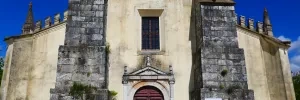
Viana do Alentejo is a pleasant town with a historic castle and good supermarkets. Given that there are few, if any, accommodation options between here and Évora, it’s an obvious place to spend the night.
The receptionist at the castle was responsible for way-marking the stage leading into Viana do Alentejo and is a good source of information about the camino, besides having an official stamp. Although the castle walls and towers can be appreciated from the outside, it’s worth paying to go in to see the striking Manueline portal of one of the two churches inside.
Leaving Viana do Alentejo, the camino to Évora is a tough stage of 36km, including 15km on a busy road (the N254) after Aguiar with possibly no shoulder to walk on depending on how recently the weeds on the side of the road have been cut. An unofficial option to break up this stage and avoid the difficult road stretch would be to head northwest from Viana do Alentejo on the N257 and join up with the N380. This would still entail road walking but the N380 is a secondary road and there are accommodation options to break up the stage, unlike on the N254.

